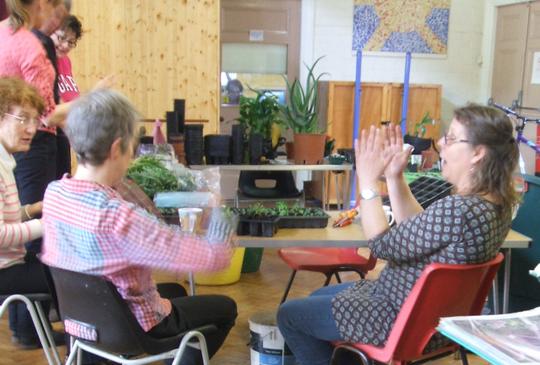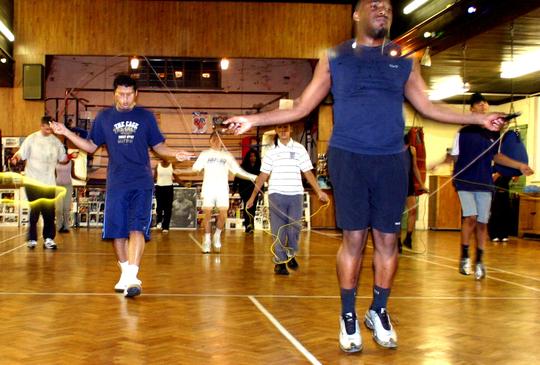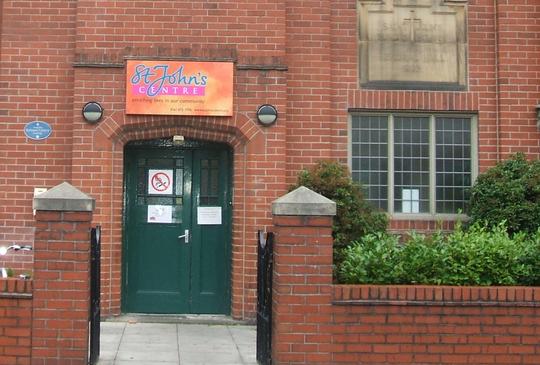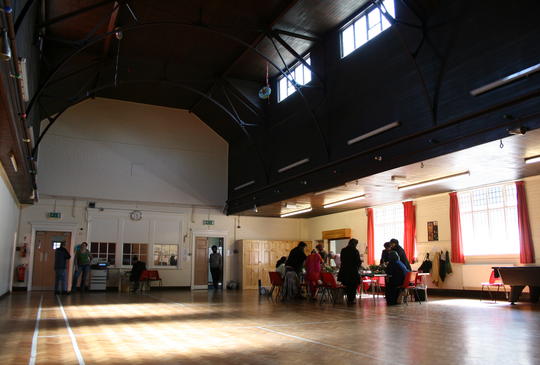
On a Wing and a Prayer: St. John's Centre, Old Trafford
St John’s Centre is an independent, voluntary organisation and community hub in Old Trafford. It was set up by St. John’s Church in 1982 to enrich the quality of life of people living in the area through adult education and various social and recreational activities. Christine Aspinall is the Centre Manager. She has been working for the Centre since it began operations in the church hall and has a lot of fascinating things to say about its value, its approach to community engagement and its main challenges. We meet in the main office at St. John’s Centre and I start by asking her about the history of the Centre and her involvement in it.
The hall, she tells me, was constructed in 1926, “serving the local parish with Sunday schools and concerts” until the 1970s, “when things seemed to change a little: the congregation went down in the church and the number of people in the Sunday schools and church groups fell.” With less money being collected from the congregation, the hall and its services were “last on the list of priorities” and they were neglected.
Then, in the 1980s, the Moss Side Riots, on the border of Old Trafford, prompted the revival of the hall as a community centre. “Our Church Council discussed how we could help the community, because there were lots of people who were unemployed and had little hope of really of finding employment and gaining skills. Somebody came up with the idea of using this space, opening the doors, getting some volunteers in to share their skills with others and helping to serve the community, to give them some support. That is when I got involved, as a volunteer, right at the beginning, because I was at that meeting and on the steering group that set it all up.”
"This is a place where people can come together with a common purpose and get to know one another at different levels and from different backgrounds."
Initially, the organisation was purely voluntary, she continues; but as it grew, the governors realised that they needed a Volunteer Co-ordinator, so they employed her part-time. That was 28 years ago. Today the Centre employs seven members of staff, including Christine, “the only full-time person at the moment”, and two part-time workers: “Emma, who is the daytime courses co-ordinator, and Elaine, whose brief is to do development work around young people’s activities and to bridge over to the church, so that we can use the space there for events, like exhibitions and concerts.”

The Centre is, she says, very busy. In the day time, it uses the hall for adult education courses, mainly for people in Old Trafford - “we have lots of courses; a full timetable.” In the evening, it lets the space to various user groups - “the brownies, the boxing club, step aerobics, that kind of thing.” Aside from that, it lets the space for private hire at the weekends, such as “children’s parties and weddings,” and uses it for its own community events. “We do daft things like a community pantomime every year for people who don’t get opportunities to go to the Palace Theatre in Manchester. They love watching us make fools of ourselves,” she says, laughing.
Overall, the building gets about 19,000 visits every year from local people. “Not having the Centre would be a big loss to this community”, Christine says. “I'm not saying there aren’t any other places where they could go to learn and socialise and interact, but places like the Old Trafford Community Centre are a bit clinical. They are lovely people that run it - very lovely - but it is not run the way we run this here. They provide things for the community, but we have got the personal touch and we work alongside people. We don’t just let user groups book rooms and leave them to it; we provide them with infrastructure support. I know there are outside bodies that can do that,” she adds, “but it is nice that we can bring them in to talk about funding and be here to support them.”
The Church is a key factor in its success, Christine says, shaping “the way we are and the way we do things.” But, although the Centre is “a Church project”, she points out that “the Church does not evangelise people when they come through the door; we respect everybody for who they are and what their background is and where they come from. This is a place where people can come together with a common purpose and get to know one another at different levels and from different backgrounds.” What matters, she says, is the “churchy” ethos – “being open and caring and wanting to make a difference to people’s lives.”
“We have got the personal touch and we work alongside people.”
It becomes clear that “wanting to make a difference” is a fundamental driver for the Centre, explaining not only its relationship with user groups – “open and caring” – but also its relationship with its adult education partners – “two-way” - and funders – “not chasing money for money’s sake”. The local college and the Workers Education Association trust the Centre to promote courses on their behalf. “They get their numbers and we get what we want: adult education for the community.” And the Centre only applies to funders who will, Christine says, “fund us for what our community wants and what we want to do.”
Unfortunately, the Centre’s funding policy is under threat. As Christine explains, up until 6 years ago the Centre had three main sources of revenue: letting space to user groups and for private functions; working with the college and the WEA and a grant from the local authority. “It costs us about £110,000 a year to run the centre – to employ staff, pay for heating and lighting and maintain the building”, she says, adding that “old buildings are notoriously expensive to run.”
Then its finances were thrown in the air by the Coalition government’s cuts to local government funding. The local authority, Trafford Borough, had to make some difficult decisions. It cut the Centre’s grant by half and then, three years ago, decided that voluntary sector grants would be opened up to all community groups through participatory budgeting, with potentially devastating effects, Christine says.
Participatory budgeting is “great for small amounts of money”, but not for core funding. “We’ll get £5000… if we’re lucky,” she says, explaining that the decision is taken by a small group of people from the community on the basis of a three-minute pitch. “It doesn’t seem to matter what you are trying to do for the community. If you can do something funny, you will get money”, she says. “We did a three-minute panto last time. We had the good fairy and the wicked baron and poor Jack who wanted to start his own group, but didn’t have anywhere to go.”

So Christine and her colleagues are busy looking for new sources of funding. One option is to tap into church funding. “Manchester Diocese has got funding pots and we’ve got some money from its Parish Mission Fund,” she says. “But those funds are going to run out. So it is getting more and more difficult.”
Another option is Reaching Communities, a Big Lottery funding programme. But, as Christine points out, that would be a temporary solution and would not cover all of the Centre’s core costs. “We would still have to pull in money from elsewhere and it would be for three years only.” There aren’t many other options, she says. “I’m thinking, ‘Where do we go, who is giving out big money nowadays that would cover our core expenses?’ There is only the Big Lottery fund.”
Funding is also a major issue because the Centre wants to grow and develop its activities. “When you do that,” Christine explains, “you need to get more funding and then more funding and then, when you’ve put all of your eggs in one basket and that funding goes, what do you do after that? It’s a Catch-22 situation. You grow and you develop and you need more money, but then, when the funding goes, you’re left trying to find even more funding because you have grown and developed and you have got more staff.”

And the Centre needs to expand, she argues. “We barely have space to meet ourselves as a staff team and it is very difficult to find space for new groups and new activities and new courses. We’ve tried using the choir vestry, which is a nice space, but it is not accessible and there is only one toilet available.”
So, the Centre is planning to create more space. In the short-term, Christine says, “we want a meeting space and a room”; and, in the long-term, “10 to 15 years off, we would like an atrium, a connecting space between the church and the hall,” adding that it “would cost a phenomenal amount of money, about half a million pounds, probably.” In the meantime, the plan is to extend the building on the side of the IT suite “with a Portakabin or a green build for a crèche and after-school activities, which would free up the crèche space.” Even that, she says, would be fantastic.
There are also plans for a catering kitchen, she continues. “That’s what we are after next. It is part of our Reaching Communities bid. We are thinking of catering and training and getting people skilled up and accredited in first aid, food hygiene and once the catering kitchen is up and running, getting someone to run it as a little social enterprise.”
Catering seems to be a key feature of the Centre’s vision for local community engagement. “We would also like to build a café on the road side of the church, but that is part of the long-term plan. That’s about using the church for the community in different ways, rather than just for worship on a Sunday. And we are building an outdoor tandoori oven - something that is pleasing to the eye, that we can use for events and that people could come and use, to cook and meet together. These are the little plans, heading up to the Big Lottery bid.”
At this point, the ideas are coming thick and fast, and one can imagine how much more of a difference Christine and her colleagues could make to the lives of people in the area, if they had the money. “We have been looking at all the grounds in the church and around the hall. We have got a poly-tunnel at the back of the hall where we are growing all sort of things. People can pick vegetables or herbs that grow. It is about inviting people in to the garden and using that space as well.”
“All in all, I think we do an awful lot on a wing and a prayer,” Christine concludes.
Further Information
For further information on St. John’s Centre please go to their website, http://www.stjohnscentre.org/
Acknowledgements
This interview is part of 'Realising the Potential of Community Hubs', a Greater Manchester Local Interaction Platform project.
Making people laugh: Brinnington Community Association, Stockport
Contributed by Alex Wharton
Contributor Profile
Alex is a Researcher at the Centre for Sustainable Urban and Regional Futures (SURF). He is currently working full-time on the Greater Manchester Local Interaction Platform (GM LIP), one of 5 LIP set up by Mistra Urban Futures, an international centre for sustainable urban futures, based in Gothenburg. His main interest is in the socio-economics of sustainable urban transitions - specifically, the relationship between economic growth and social justice, and the ways in which local authorities engage with local communities.





